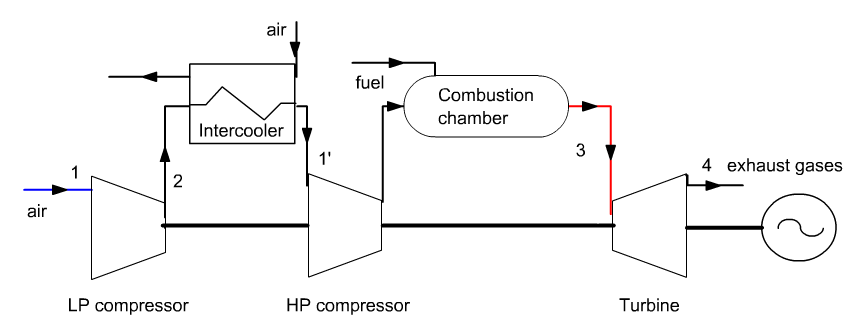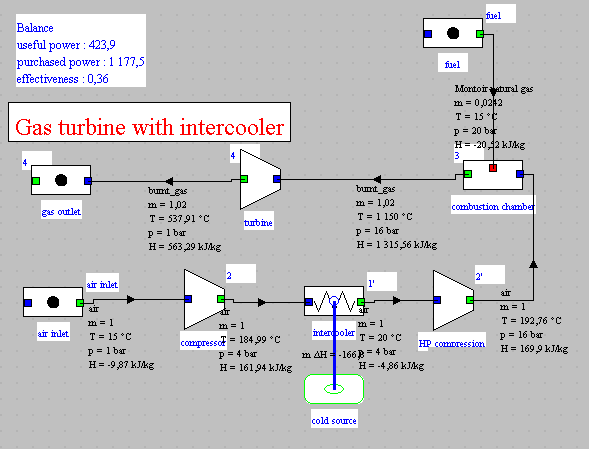Introduction

Another idea to improve the gas turbine cycle is to stage the compression. This operation can be repeated several times if necessary.
Let's consider the case of a so-called cycle with intercooler in which the compression is staged. At the outlet of the first compression process, the air at 185 ° C is cooled by exchange with outside air at 15 ° C, which makes it possible to lower its temperature to 20 ° C. It is then recompressed at the final pressure, the compression work being lower.
However, as the outlet temperature of the second compression process has also dropped, more heat must be supplied to the combustion chamber. However, the overall balance remains beneficial: it mainly results in an increase in power and a very small gain in efficiency.
The difficulty is that the morphology of gas turbines which lead to the best performance is generally not well suited to intermediate cooling, so that this solution is rarely used. In this directed exploration, we will study the staged compression cycle.
Loading the model of the staged compression gas turbine
We will now study the staged compression cycle.
Loading the model
Click on the following link: Open a file in Thermoptim
You can also:
- either open the "Project files/Example catalog" (CtrlE) and select model m9.2 in Chapter 9 model list.
- or directly open the diagram file (IC_GT.dia) using the "File/Open" menu from the diagram editor menu, and the project file (IC_GT.prj) using the "Project files/Load a project " menu from the simulator.
The efficiency is 36% instead of 35.8%, but above all the power increases from 318 kW to 424 kW, due to the decrease in compression power.
The reason why the efficiency varies little is that the gain made on the compression power results in an inlet temperature in the combustion chamber much lower than in the simple gas turbine (193 °C instead of 442 °C). To reach the turbine inlet temperature of 1150 °C, this drop in temperature must be compensated for by a thermal power roughly equivalent to the mechanical power gained.
Note that the end of compression temperature being much lower than in the simple cycle, additional regeneration would be beneficial.
Model settins
As we have indicated, the new model implements two new components, the HP compressor and the intermediate pressure compressed air cooling process, here called "intercooler". For the sake of simplicity, we have not modeled the exchanger with the ambient air, we only set a cooling to the temperature of 20 °C.
The settings of the model do not pose any particular difficulty.
Application exercises
Influence of the intermediate pressure
What is the value of the intermediate pressure which leads to the best efficiency?
Cycle with intercooling and regeneration
The modification of the cycle that we made by splitting the compression makes it possible to reduce the energy consumption of the compressor, but it is offset by the additional consumption of fuel to compensate for the lower temperature at the inlet of the combustion chamber.
As the temperature difference between the gases leaving the turbine and the compressed air has increased, the conditions are favorable for the implementation of regeneration.
This makes it possible to obtain greater performance, both in terms of efficiency and in terms of machine power output.
Loading the model
Click on the following link: Open a file in Thermoptim
You can also:
- either open the "Project files/Example catalog" (CtrlE) and select model m9.3 in Chapter 9 model list.
- or directly open the diagram file (regenIC_GT.dia) using the "File / Open" menu from the diagram editor menu, and the project file (regenIC_GT.prj) using the "Project files/Load a project " menu from the simulator.
In this model, we have retained an effectiveness of 85% for the regeneration exchanger.
Energies put into play

For comparison, here are the performance values of the gas turbine cycle with regeneration but without staged compression.
As you can see, the combination of staging and regeneration has a strong influence on the performance of the machine.
What is the increase in mechanical power?
What is the increase in thermal power?
Conclusion
This exploration allowed you to discover a model of gas turbine with intermediate cooling and to analyze the sensitivity of this model as a function of the intermediate pressure.
It has shown that the best performance is obtained by combining compression staging and regeneration.
Analogously to what has been presented here, it would be possible to stage the expansion.
Study by yourself the influence of the intermediate pressure on the performance of For this, vary between 2 and 12 bar the intermediate pressure of point 2 at the outlet of the compressor process, then recalculate each time first the point then the process.
Then recalculate several times in the simulator screen until the balance stabilizes.